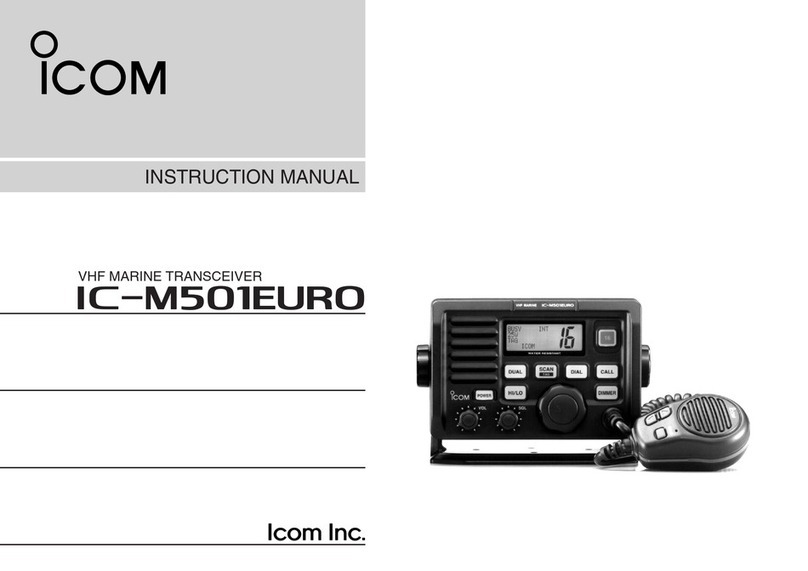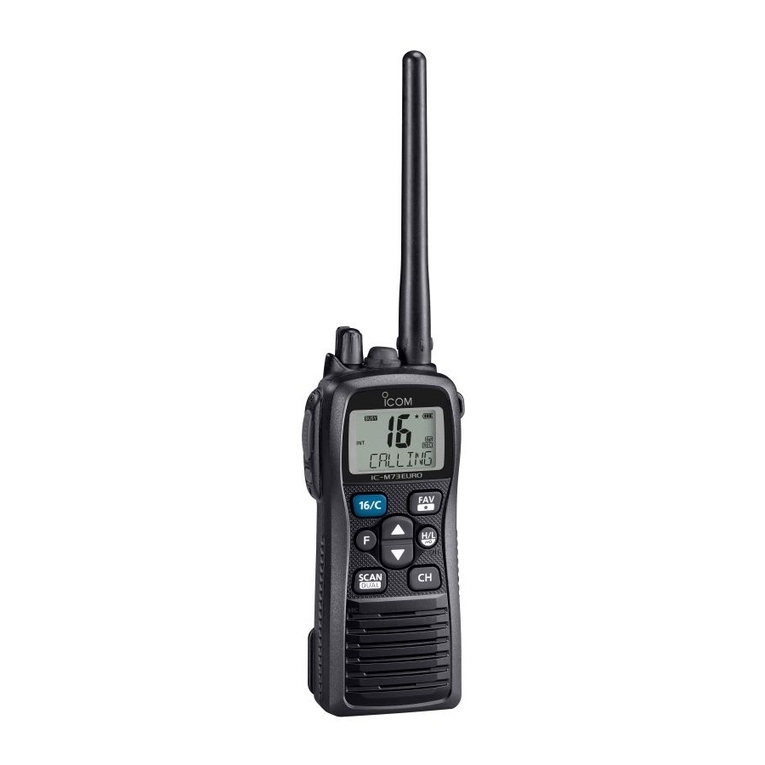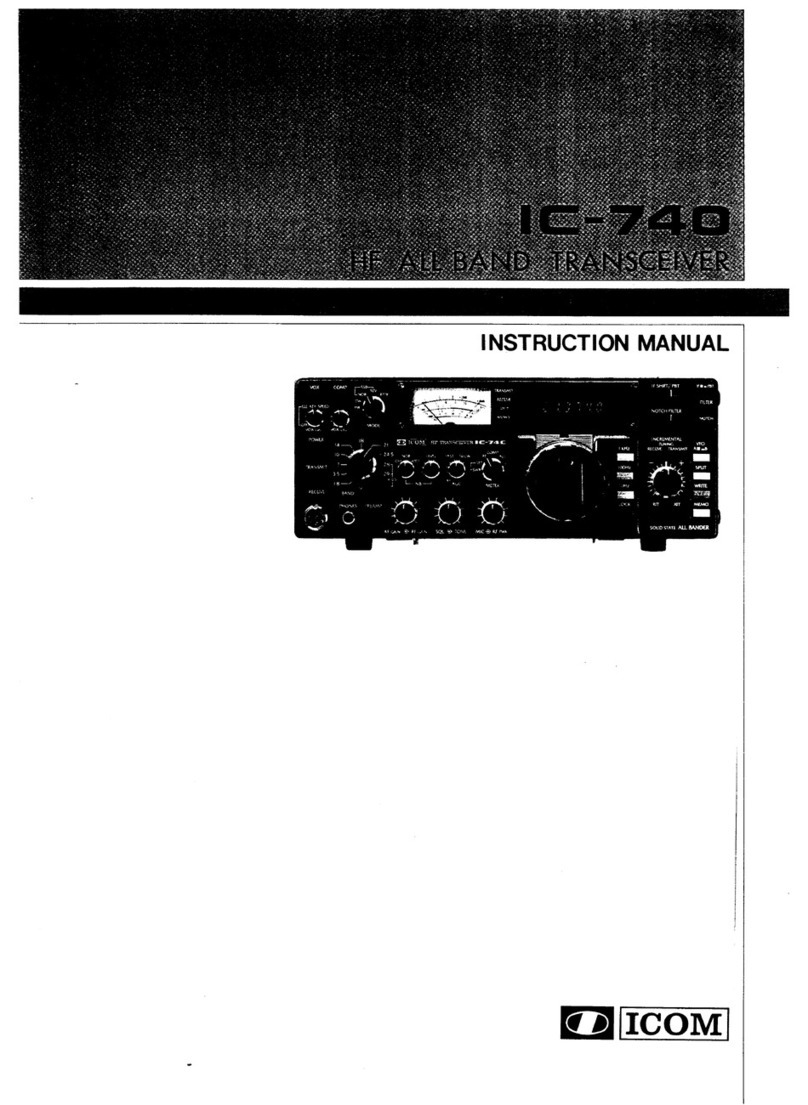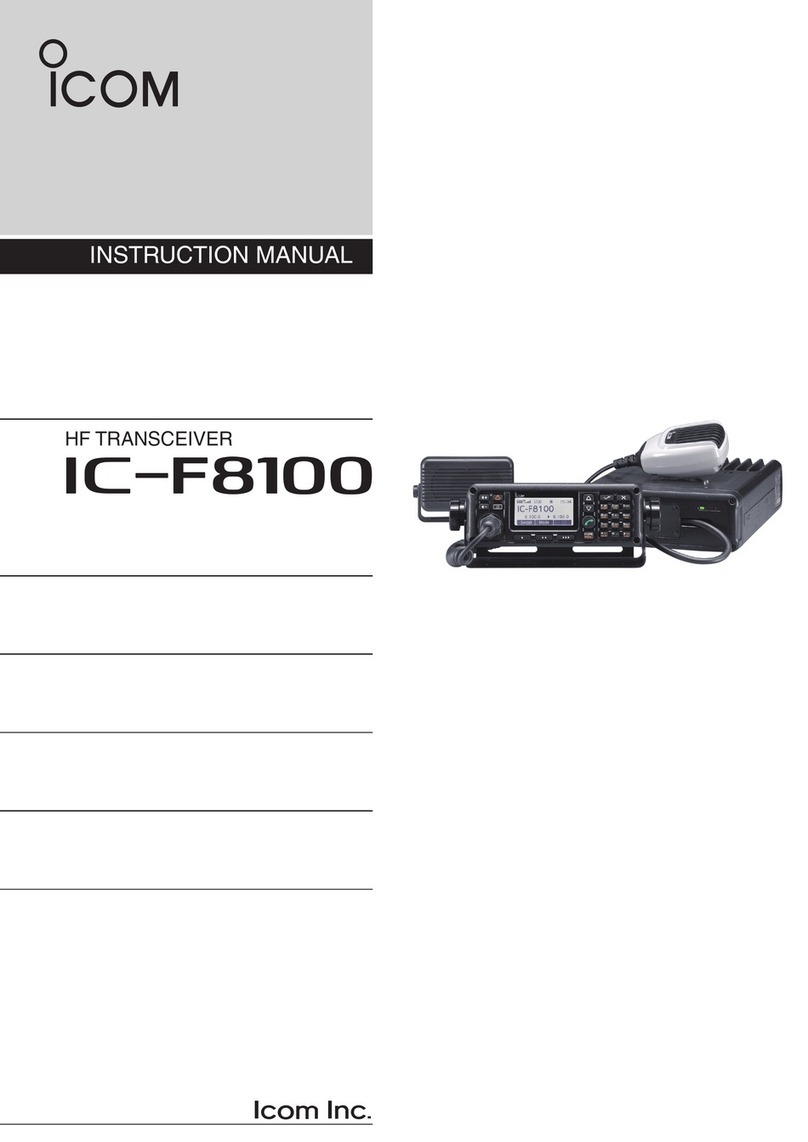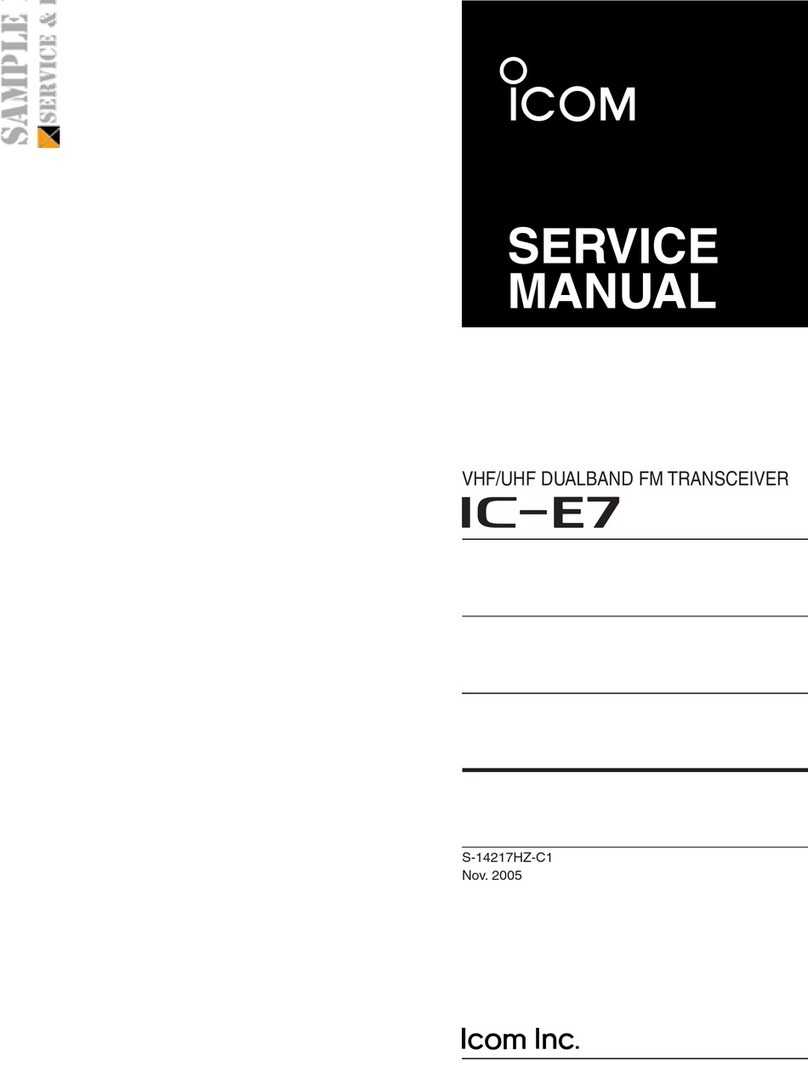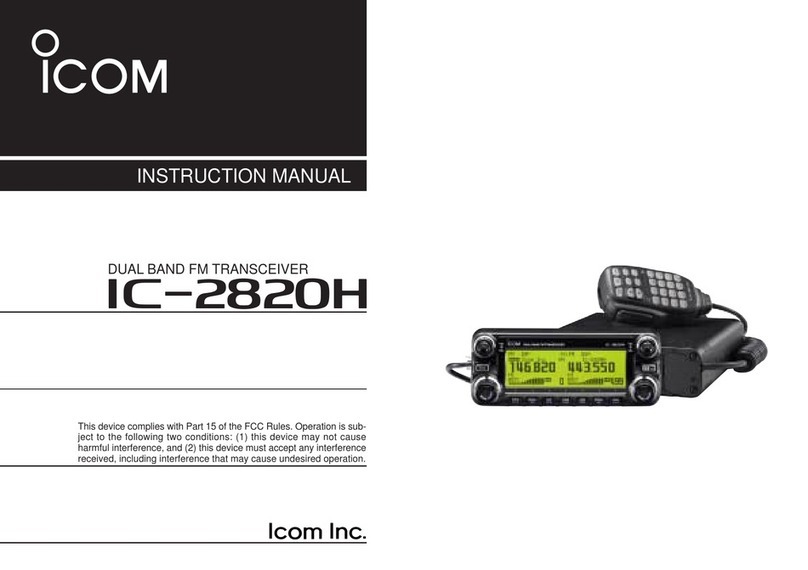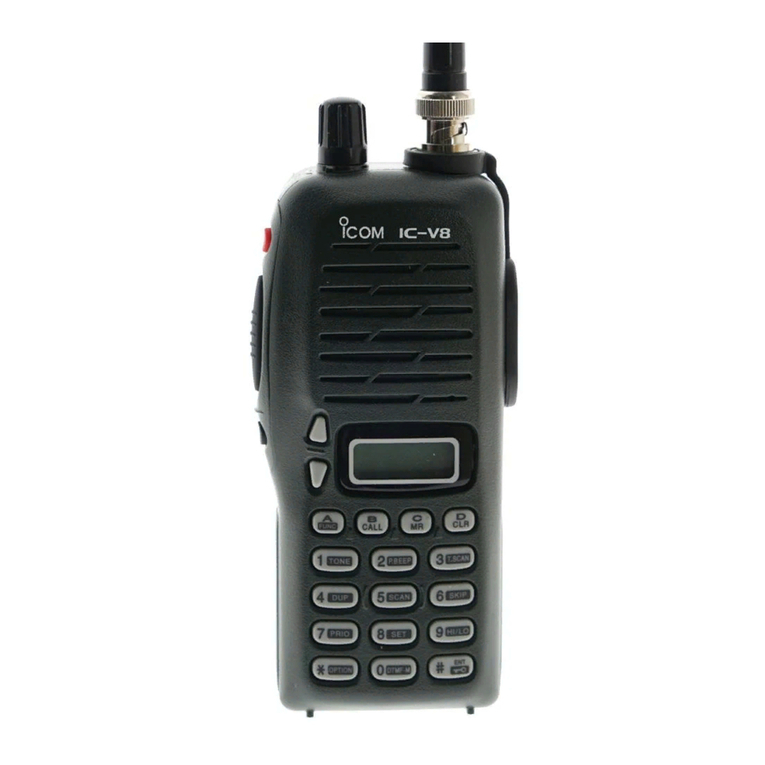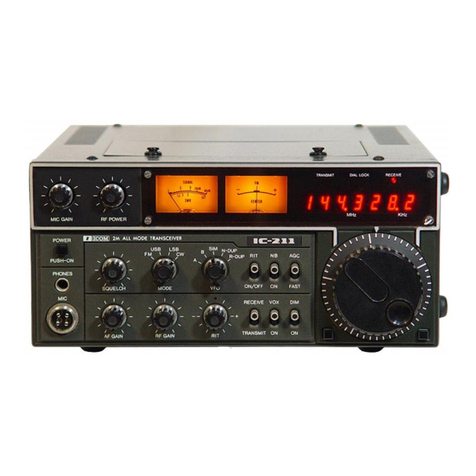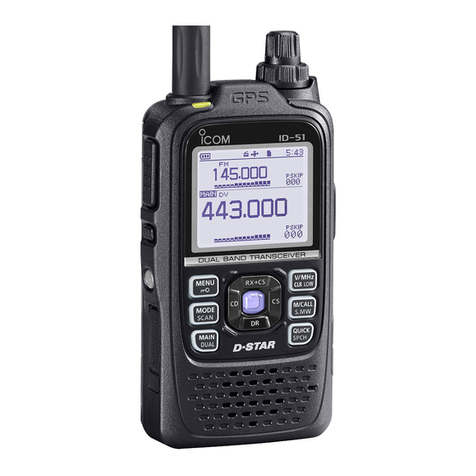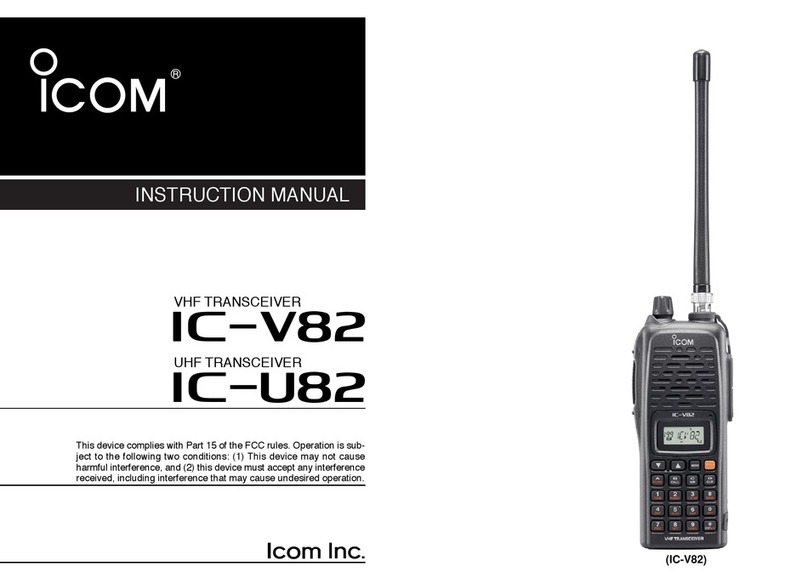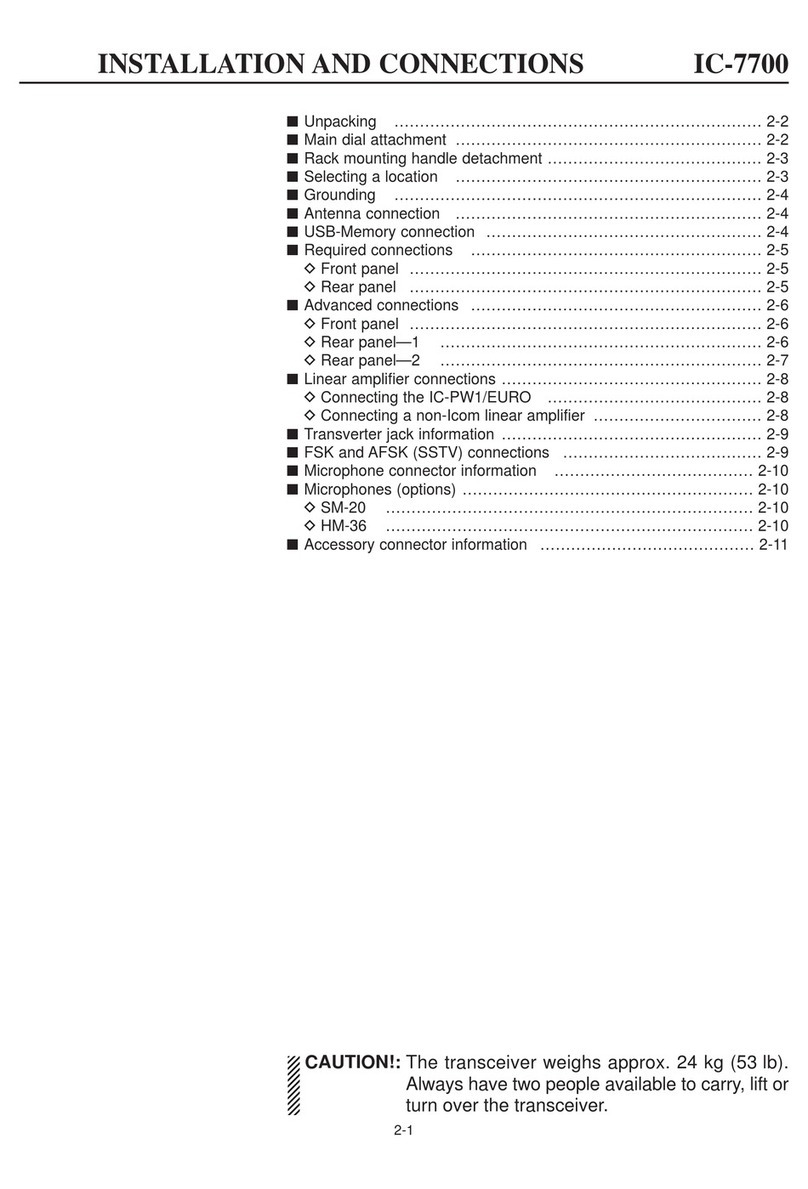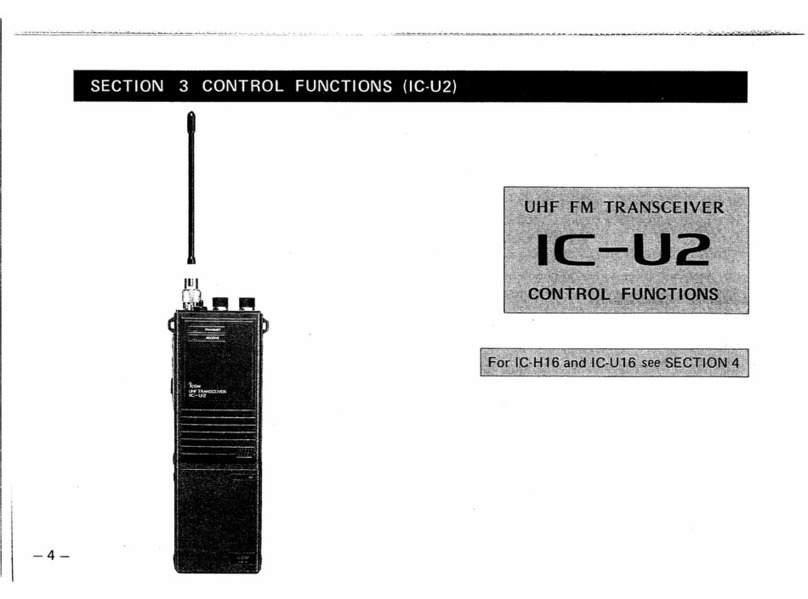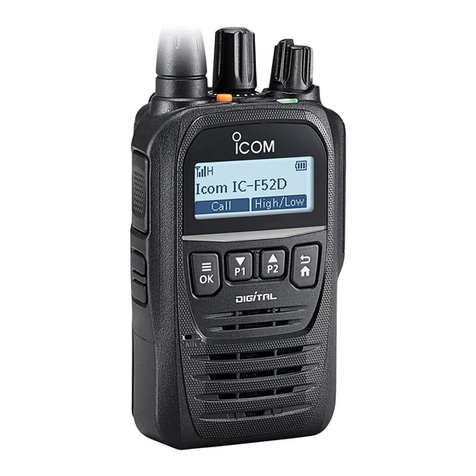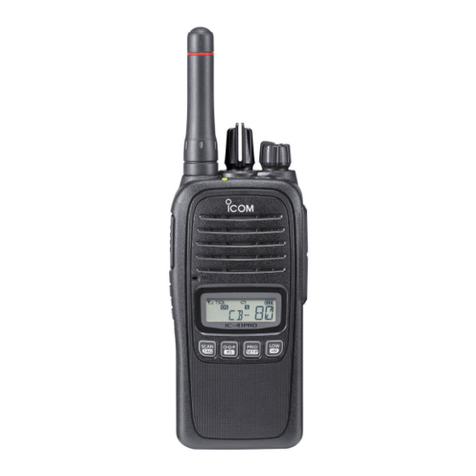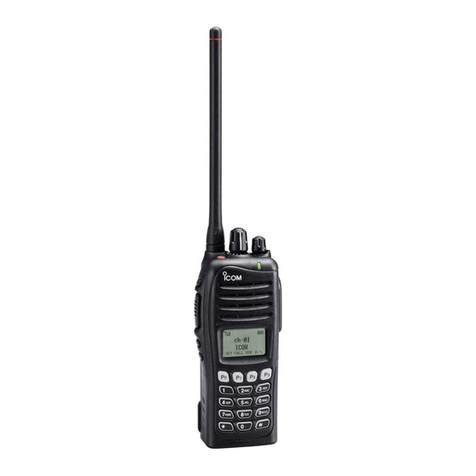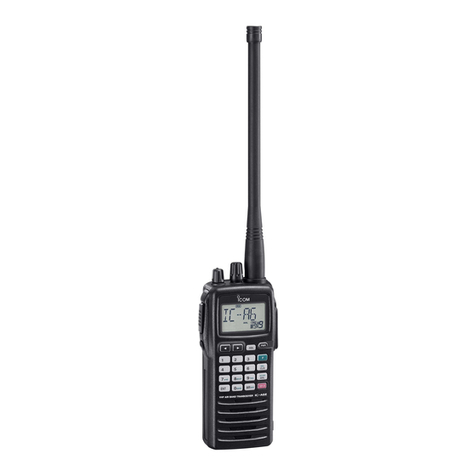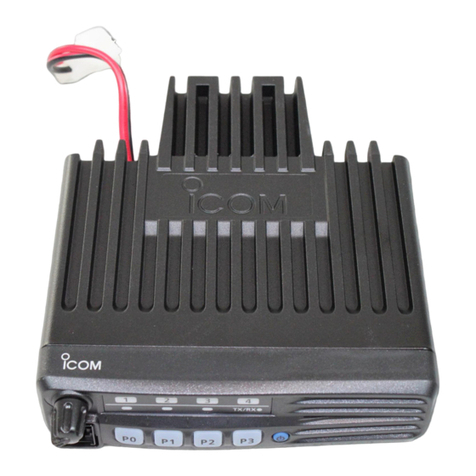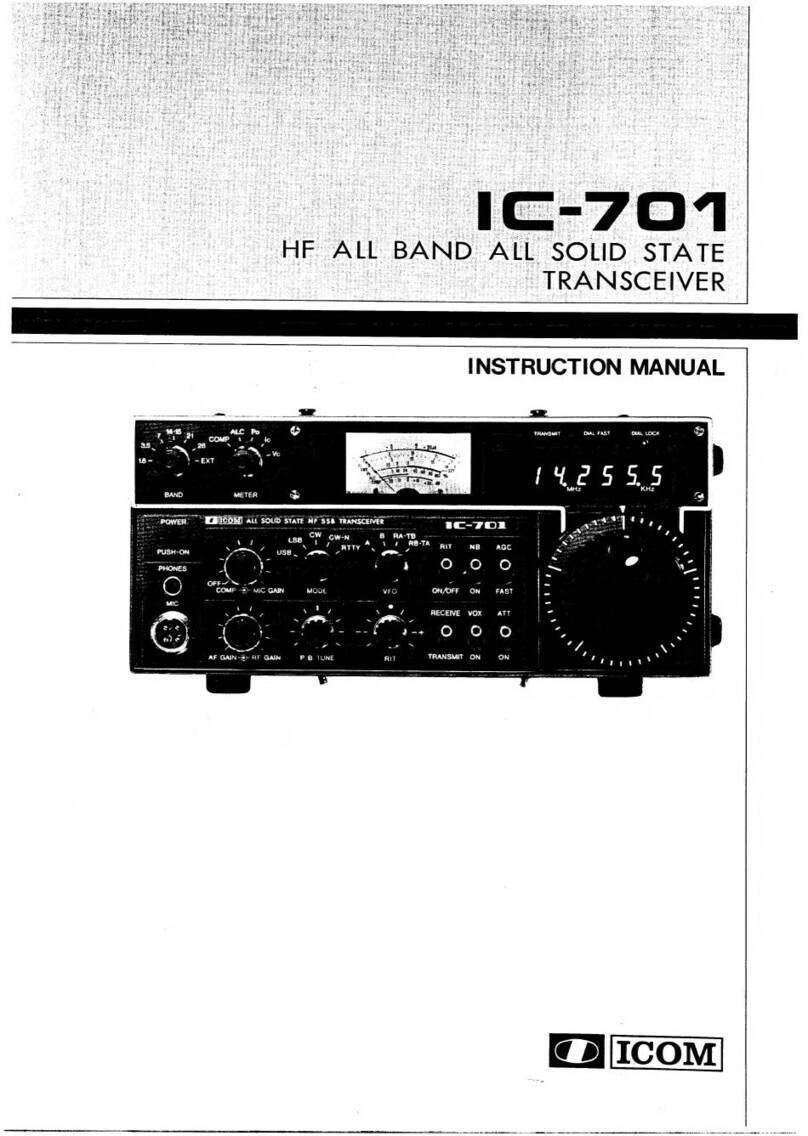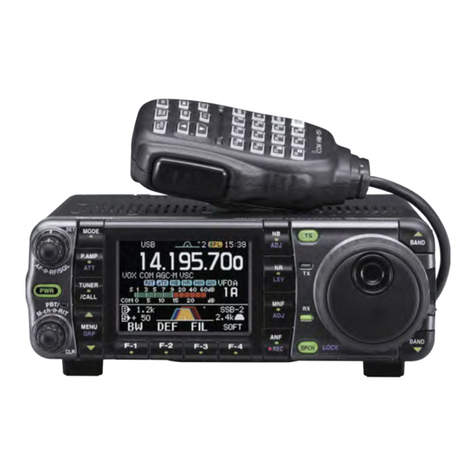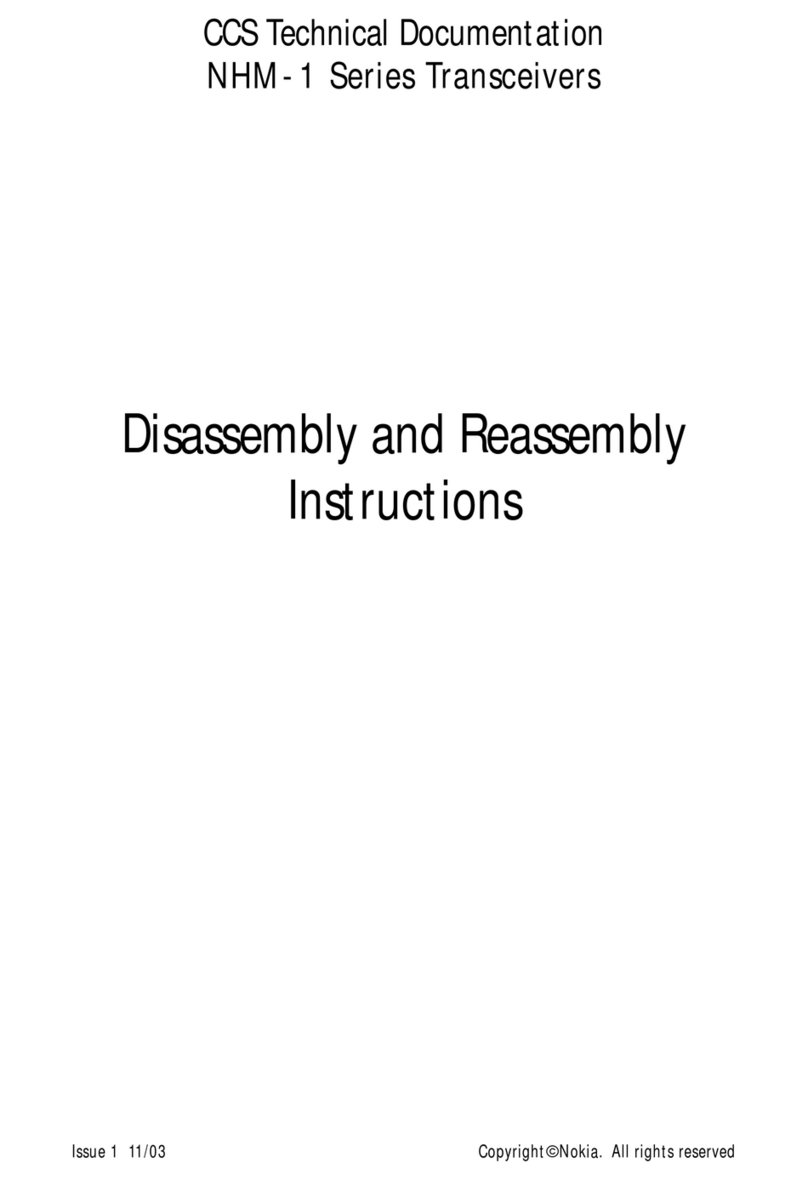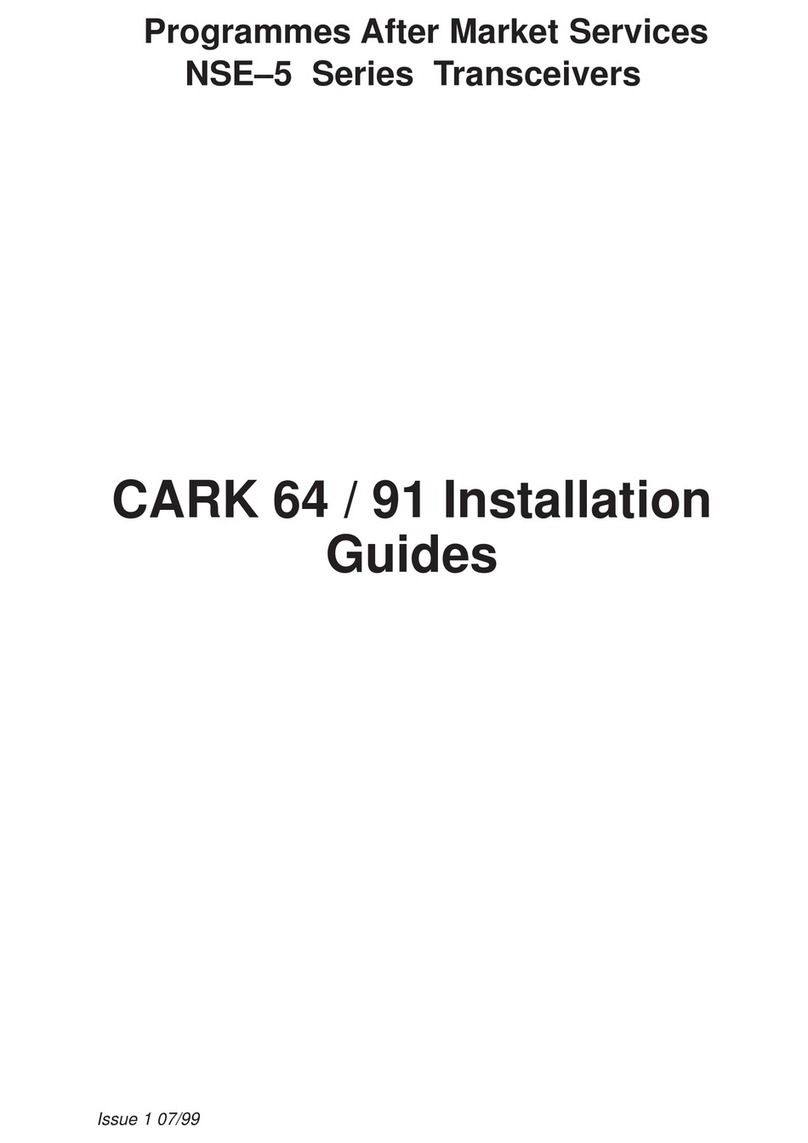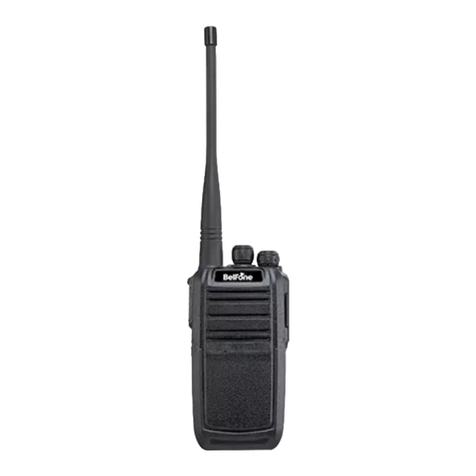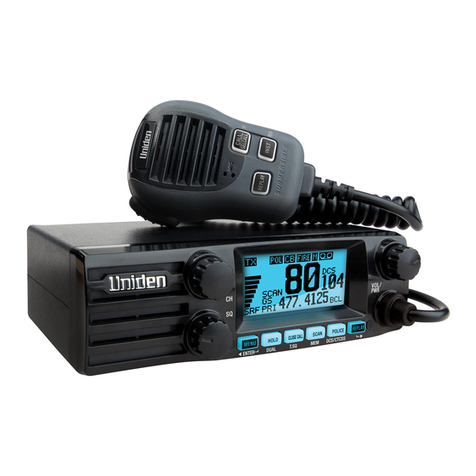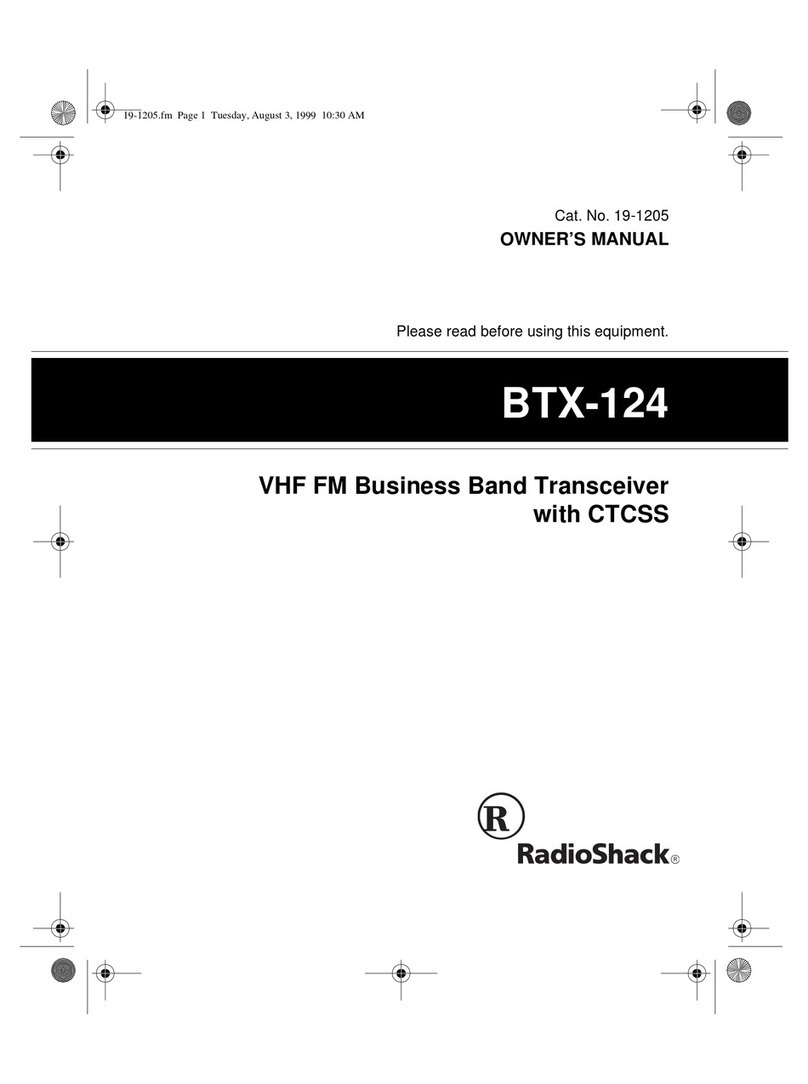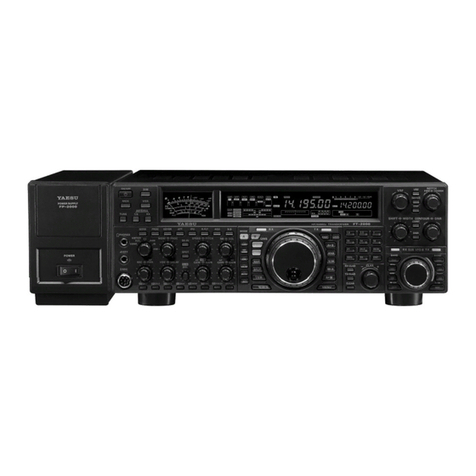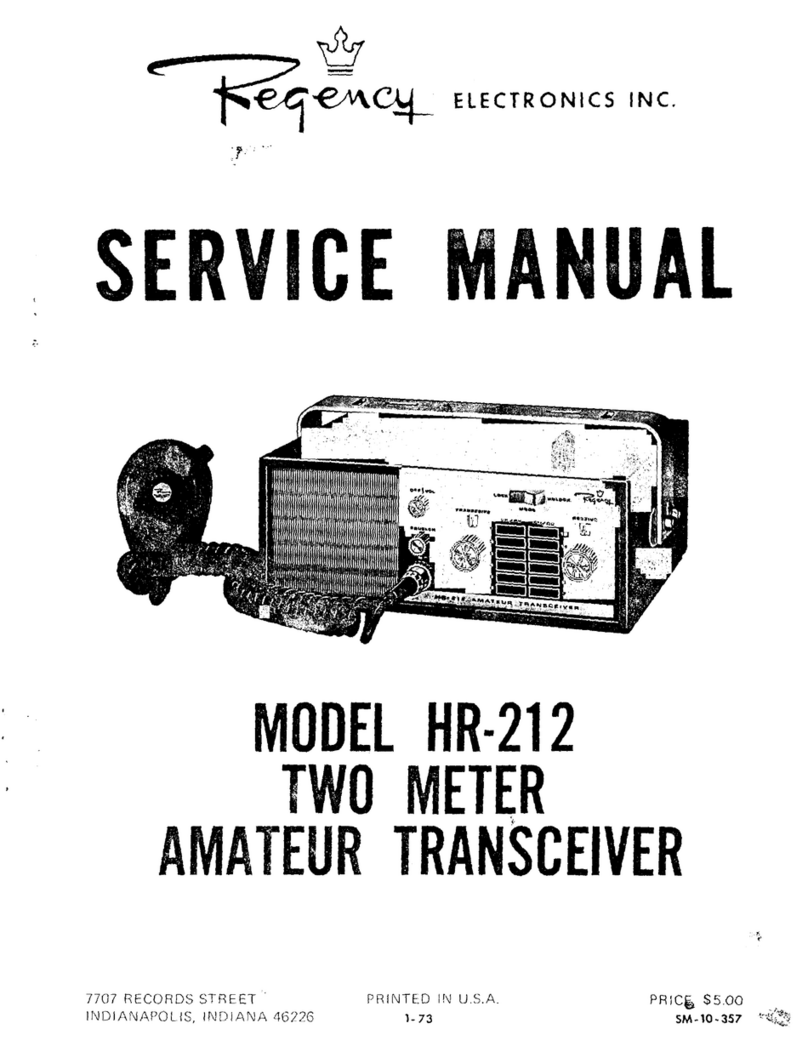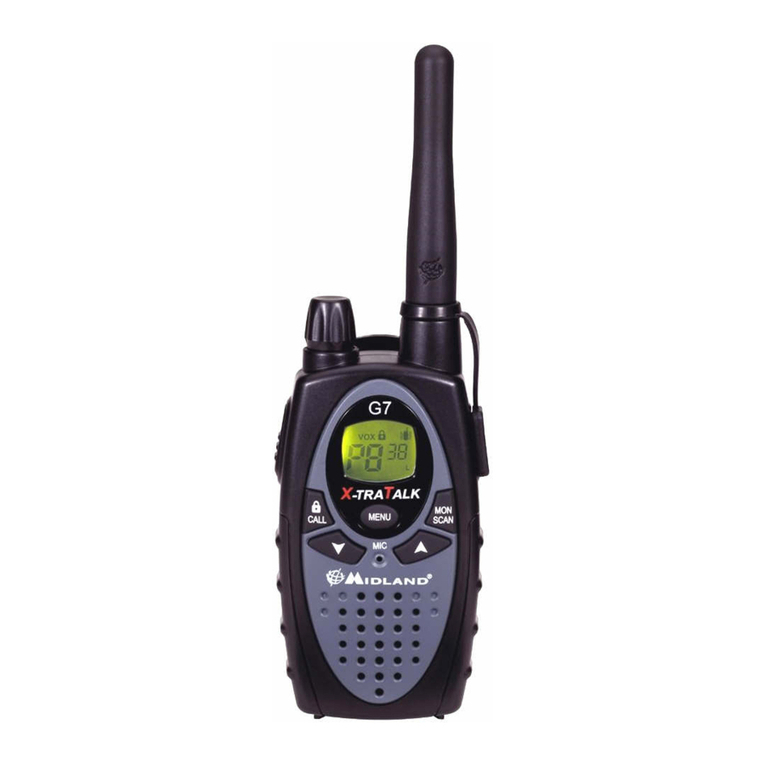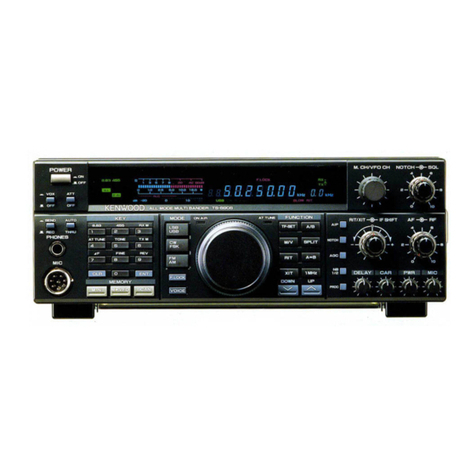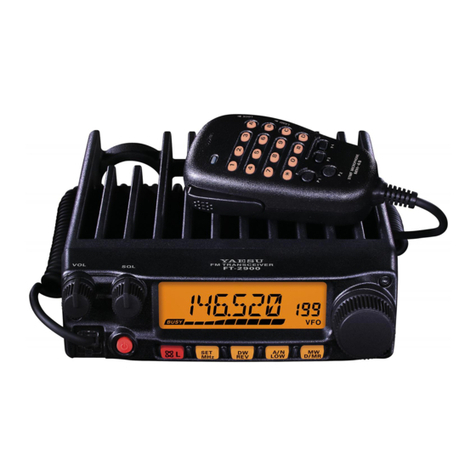Icom IC-A200 User manual

INSTRUCTION
MANUAL
VHF
AIR
BAND
TRANSCEIVER
IiC—A200
Icom
Inc.

IMPORTANT
READ
THIS
INSTRUCTION
MANUAL
CARE-
FULLY
before
attempting
to
operate
the
transceiver.
SAVE
THIS
INSTRUCTION
MANUAL.
This
instruction
manual
contains
important
safety
and
operating
instructions
for
the
IC-A200.
FOREWORD
Thank
you
for
purchasing
the
IC-A200
VHF
AIR
BAND
TRANSCEIVER
with
Icom’s
state-of-the-art
technology.
The
IC-A200
can
be
installed
in
your
instrument
pane!
and
is
easy
to
operate,
To
fully
appreciate
the
capabilities
of
your
IC-A200,
please
read
this
instruction
manual
thoroughly
before
attempting
operation.
If
you
have
any
questions
regarding
the
operation
of
the
IC-A200,
feel
free
to
contact
your
nearest
authorized
Icom
Avionics
Dealer
or
Service
Center.
CAUTIONS
NEVER
connect
the
transceiver
to
an
AC
outlet
or
to
a
Power
source
of
more
than
16
V
DC.
Higher
voltage
ruins
the
transceiver,
NEVER
connect
the
transceiver
to
a
power
source
using
reverse
polarity.
This
connection
ruins
the
transceiver.
AVOID
using
or
placing
the
transceiver
in
areas
with
temperatures
below
—
20°C
or
above
+50.
DO
NOT
turn
the
power
ON
until
the
aircraft
engines
have
been
started.
This
is
important
for
protection
of
the
circuit.
EXPLICIT
DEFINITIONS
7
hazard
or
electric
ace
sh
Personal
injury,
ire
may
occur.
[CAUTION
|
Equipment
damage
may
occur.
If
ignored,
inconvenience
only.
No
personal
injury
or
risk
of
electric
shock.

TABLE
OF
CONTENTS
IMPORTANT.
.....0seseeersseere
aaunbbvaesesashandsncassaesbtoanenctes
esconsael
FOREWORD.........0:00000
ennseeunecae
asmnnnsticinsucusvanrosasvasesboosae
|
CAUTIONS.
.......:ccceeestreeeeeneeeeene
screeuecccnssenenencucseoesses!
|
EXPLICIT
DEFINITIONS...
TABLE
OF
CONTENTG...........
pa
cesabitdaesunasisbagvanscenponAceail
ll
1.
PANEL
DESCRIPTION........
1-2
@
Front
panel........
|
@
Function
display....
2
ous
@
Remote
switches
and
jacks....
2.
FREQUENCY
SELECTION...
@
Frequency
selection
methods.
W@STBY
window
frequency
selection
@
Frequency
exchanging............+
USE
window
frequency
selection...
@
Frequency
set
example......
3.
RECEIVING
AND
TRANSMITTING
@
Receiving....
@
Transmitting
4.
MEMORY
OPERATION..
@
Programming
notes
@
Programming
a
memory
channel...
@
Programming
example.
i
Memory
recall
in
the
STBY
window.
@
Memory
recall
in
the
USE
window..
@
Memory
recall
example....
@
Remote
memory
selection.
5.
REMOVAL
AND
INSTALLATION...........::ceceeeseeeenee
11
@
Transceiver
removal
es
@
Transceiver
installation...
6.
SPECIFICATIONS.
oom}
@
General......
wih
@
Transmitter.
@
Receiver.

m=
1
PANEL
DESCRIPTION
i
Front
panel
MEMO
J]
CH
@
LARGE
TUNING
KNOB
—
Changes
the
STBY
or
USE
window
frequency
in
1
MHz
steps.
(pgs.
3~4)
—
Selects
a
memory
channel.
(pgs.
7~10)
—Programs
a
selected
memory
channel
as
a
blank
channel.
(p.
7)
@SMALL
TUNING
KNOB
—
Changes
the
STBY
or
USE
window
frequency
in
25
or
50
kHz
steps.
This
knob
does
not
change
the
1
MHz
digit.
(p,
3~4)
—
Selects
a
memory
channel.
(pgs.
7~10)
©
VOLUME
CONTROL
—Turns
power
ON
and
adjusts
the
audio
level.
(p.
6)
—When
pulled
OUT,
opens
the
squelch
manually
for
testing.
(p.
6)
@
CHANNEL
SWITCH
[CH]
—
Recalls
a
memory
channel
in
the
STBY
window.
(p.
7)
—When
pushed
and
held,
allows
memory
channel
pro-
gramming.
(p.
7~8)
@
FREQUENCY
EXCHANGE
SWITCH
[==]
—Exchanges
the
USE
window
frequency
for
the
STBY
window
frequency
and
vice
versa.
(p.
4)
—When
pushed
and
held,
hides
the
STBY
window
frequency
and
allows
selection
of
the
USE
window
frequency
directly.
(p.
4)

@
Function
display
wi
id
-
(LS
CH
Es
®
9
@USE
WINDOW
Indicates
the
operating
frequency
that
is
used
for
trans-
mitting
and
receiving.
@
TRANSMIT
INDICATOR
Appears
while
transmitting.
(p.
6)
@OSTBY
WINDOW
—
Indicates
the
standing-by
frequency
which
is
used
as
the
next
operating
frequency.
—When
a
memory
channel
is
recalled,
indicates
the
memory
channel
frequency
content.
©
MEMORY
CHANNEL
INDICATOR
Indicates
a
selected
memory
channel
number.
(pgs.
7~10)
@
PROGRAMMING
INDICATOR
Indicates
that
a
memory
channel
can
be
programmed.
(pgs.
7~8)
PANEL
DESCRIPTION
1
i
Remote
switches
and
jacks
The
following
switches
and
jacks
can
be
installed
on
your
aircraft.
Ask
your
Icom
Avionics
Dealer
for
wiring.
Headphone
Jack
Connects
a
500
Q
headset.
Microphone
audio
jack
Connects
a
low-impedance
carbon
or
dynamic
microphone.
A
preamplifier
is
required
for
a
dynamic
microphone.
Yoke-mounted
communicatlon/intercom
switch
—Set
to
the
“communication”
position
for
the
air
band.
(p.
6)
—Set
to
the
“intercom”
position
to
talk
with
a
crew
member.
This
allows
communication
between
the
pilot
and
co-pilot.
(p.
6)
Yoke-mounted
channel
switch
Remotely
selects
a
memory
channel.
(p.
9)
¢
Cannot
be
used
for
memory
channel
programming.
Yoke-mounted
frequency
exchange
switch
Remotely
exchanges
the
USE
window
frequency
for
the
STBY
window
frequency
and
vice
versa.

—e
ol
i
Frequency
selection
methods
There
are
2
ways
to
select
a
desired
frequency.
General
frequency
selection
Select
a
desired
frequency
which
is
used
for
the
next
operating
frequency
in
the
STBY
window.
Then,
ex-
change
the
USE
window
frequency
for
the
STBY
window
frequency.
Refer
to
STBY
window
frequency
selection
at
right
and
frequency
exchanging.
(p.
4)
Direct
frequency
selection
Select
a
desired
frequency
in
the
USE
window
directly.
Refer
to
USE
window
frequency
selection.
(p.
4)
CONVENIENT:
For
quick
frequency
selection,
often-
used
frequencies
can
be
programmed
into
memory
channels.
Refer
to
memory
operation.
(pgs.
7~10)
When
a
memory
channel
is
recalled,
the
previous
STBY
window
frequency
is
erased.
FREQUENCY
SELECTION
i
STBY
window
frequency
selection
CAUTION:
DO
NOT
tum
the
power
ON
until
the
aircraft
engines
have
been
started.
This
is
important
for
protection
of
the
circuits.
1)
Rotate
the
volume
control
clockwise
to
turn
the
power
ON.
«
Previously
used
frequencies
appear
in
the
USE
and
STBY
windows.
2)
Rotate
the
large
and
small
tuning
knobs
to
select
a
desired
frequency.
The
USE
window
frequency
is
not
affected.
«To
change
the
1
MHz
digit,
use
the
large
tuning
knob.
The
small
tuning
knob
does
not
change
the
1
MHz
digit.
1
MHz
steps.
50
kHz
steps
25
kHz
steps
when
pushed
IN.
when
pulled
OUT.

li
Frequency
exchanging
After
selecting
the
STBY
window
frequency,
push
[==]
to
exchange
the
USE
window
frequency
for
the
STBY
window
frequency.
Frequency
exchanging
can
also
be
performed
remotely
from
the
yoke-mounted
frequency
exchange
switch.
HBG
(26.00
Push
=)
NOTE:
DO
NOT
push
and
hold
[=]
continuously,
or
the
STBY
window
frequency
disappears.
FREQUENCY
SELECTION
2
i
USE
window
frequency
selection
The
USE
window
frequency
can
be
selected
directly
without
frequency
selection
in
the
STBY
window.
1)
Push
and
hold
[=]
until
the
STBY
window
frequency
is
hidden.
eThe
yoke-mounted
frequency
exchange
switch
cannot
be
used.
Push
and
hold
The
STBY
window
frequency
is
hidden.
2)
Select
a
desired
frequency
using
the
large
and
small
tuning
knobs.
3)
Push
[=].
¢
Previous
STBY
window
frequency
appears.
“i

al
2
FREQUENCY
SELECTION
i
Frequency
set
example
The
following
is
an
example
of
how
to
select
126.125
MHz
in
the
STBY
window,
and
then
transfer
it
to
the
USE
window.
Rotate
clock-
I
rm
1 1
mr
Previously
used
frequencies
appear.
Dies.
(O
(34.8¢
i2
4G
on
Test
O)
Select
126.40
(/7->COMM
1
nm
1
nm
Rotate
the
large
tuning
knob
to
MHz.
‘
‘
Jj
uy
|
uw
iZ
6.
be
change
the
STBY
window
frequency
in
1
MHz
steps.
OMM
Rotate
the
small
tuning
knob
to
©)
on
NeeI6
6}
i
|
uf
HH
i
e
6.
i
5
change
the
STBY
window
frequency
in
50
kHz
steps.
Pull
OUT
to
COMM
|
¢
nm
‘ ‘
Pull
OUT
the
small
tuning
knob
to
@
select
25
kHz
—6)
UJ
34.
aa
i26.
‘
5
select
25
kHz
steps.
steps.
Select
126.125
OMIM
Tg
nm
‘
t
Rotate
the
small
tuning
knob
to
©
MHz.
6;
U
|
4.4
aw
iZ
6.
ie
S
change
the
STBY
window
frequency
in
25
kHz
steps.
The
USE
window
frequency
and
the
@
Pun)
iZ
B.
id
5
i
=]
oY,
8a
STBY
window
frequencies
are
ex-
*
DO
NOT
hold.
changed.

RECEIVING
AND
TRANSMITTING
oz
i
Receiving
1)
Select
an
operating
frequency.
¢
Refer
to
pgs.
3~4
for
details.
2)
Pull
the
volume
control
OUT
to
open
the
squelch
manually.
3)
Rotate
the
volume
control
to
adjust
the
audio
level.
4)
Push
the
volume
control
IN
to
close
the
squelch.
The
squelch
automatically
opens
only
when
a
signal
is
received.
When
pulled
OUT
When
pushed
IN
The
squelch
opens
only
when
a
signal
is
received
CONVENIENT:
The
intercom
function
is
useful
for
swift
communication
between
the
pilot
and
co-pilot.
The
squelch
opens
manually.
Set
the
communication/intercom
switch
on
the
VHF
control
panel
to
the
“intercom”
position.
Voice
signals
from
the
microphone
are
sent
to
both
the
pilot
and
co-pilot’s
headsets.
i
Transmitting
NOTE:
To
prevent
interference,
listen
on
the
frequency
before
transmitting.
If
the
frequency
is
busy,
wait
until
the
frequency
is
clear.
1)
Select
the
yoke-mounted
communication/intercom
switch
to
the
“communication”
position.
2)
Select
an
operating
frequency.
3)
Push
the
PTT
switch.
©
“TX"
appears.
4)
Speak
into
the
microphone
at
your
normal
voice
level.
#DO
NOT
set
the
microphone
too
closely
to
your
mouth
or
speak
too
loudly.
This
may
distort
the
signal.
5)
Release
the
PTT
switch
to
receive.

a
4
sl
MEMORY
OPERATION
i
Programming
notes
Blank
channel
A
memory
channel
with
no
frequency
content
is
called
a
blank
channel.
When
a
blank
channel
is
selected
while
programming,
“
—-
—
—
—
"
appears
instead
of
a
frequency.
Switch
operation
Note
that
“push”
and
“push
and
hold”
performs
different
functions
at
right.
The
yoke-mounted
channel
switch
cannot
be
used
for
memory
channel
programming.
During
memory
channel
programming,
if
no
operation
is
performed
for
approx.
15
sec.,
the
transceiver
automatically
operates
as
following:
—Writes
the
selected
frequency
into
the
selected
memory
channel.
—
Returns
to
normal
operation.
Protect
channel
To
prevent
accidental
changes,
required
memory
channels
can
be
specified
as
protected
channels.
Even
if
[«==]
is
pushed
and
held,
the
frequency
content
does
not
blink
and
it
cannot
be
changed.
Your
Icom
Avionics
Dealer
can
activate
and
cancel
this
setting.
Mi
Programming
a
memory
channel
The
transceiver
is
equipped
with
9
memory
channels.
You
can
program
often-used
frequencies
into
them.
1)
Push
and
hold
[CH]
until
the
memory
channel
number
blinks.
2)
Rotate
the
large
or
small
tuning
knob
to
select
a
memory
channel
to
be
programmed.
3)
Push
[=].
¢
Frequency
content
or
“—
— —
—"
blinks.
4)
Rotate
the
large
and
small
tuning
knobs
to
select
a
desired
frequency.
5)
Push
[CH]
to
return
to
normal
operation.
NOTE:
To
program
other
memory
channels
successively
push
[==]
after
step
4)
and
repeat
steps
2)~4).
To
program
a
memory
channel
as
a
blank
channel,
select
“—
—-—
-—
."
Using
the
large
tuning
knob,
“-
- -
-”
appears
between
118
MHz
and
136
MHz.

MEMORY
OPERATION
4
i
Programming
example
The
following
is
an
example
of
how
to
program
121.40
MHz
into
memory
channel
4.
Start
from
any
®
display.
@®
Push
and
hold
(_)°H
Select
memory
{7m
®
channel
4.
©
@
PushC+—>
)
¢DO
NOT
hold.
far
6)
Orn
eae
40
MHz.
©
Push
(__)°H
«DO
NOT
hold.
(I4.8G
i26.00
“PG"
and
the
previously
used
memory
channel
appears.
(94.80
eof
8.
iG
=3
—
-—-—-—"
appears
when
no
fre-
‘34.8d
a
i
has
been
programmed
_
into
memory
channel
4.
Frequency
content
or
“—
—
—
—"
4
blinks.
(94.80
(F480
oof
4D
4]
(94.80
(26.00
Previous
STBY
window
frequency
appears.

4
MEMORY
OPERATION
Hi
Memory
recall
in
the
STBY
window
Memory
channel
selection
is
performed
in
the
STBY
window.
1)
Push
[CH].
¢
DO
NOT
push
and
hold
[CH],
or
another
function
is
activated.
e
Perform
next
step
below
within
5
sec.
(F488
'26.00
“crs
“MEMORY”
and
sone
gs
memory
channel
appear.
2)
Rotate
the
large
or
small
tuning
knob
to
select
a
memory
channel.
e
When
any
switches
or
tuning
knobs
are
not
operated,
after
5
sec.,
the
memory
channel
content
is
automat-
ically
transferred
into
the
STBY
window.
(34.80
ie
ta
"cw
Disappears
after
5
sec.
Mi
Memory
recall
in
the
USE
window
For
quick
operation
in
the
USE
window,
a
recalled
memory
channel
can
be
transferred
into
the
USE
window
without
waiting
for
5
sec.
1)
Push
[CH].
¢
DO
NOT
push
and
hold
[CH],
or
another
function
is
activated.
2)
Rotate
the
large
or
small
tuning
knob
to
select
a
memory
channel.
an
|
(ig
126.0
3)
Push
[=].
The
memory
channel
content
is
copied
into
the
USE
window.
©
The
previous
USE
window
frequency
is
transferred
into
the
STBY
window.
(6.00
148.

MEMORY
OPERATION
4
Mi
Memory
recall
example
The
following
is
an
example
of
how
to
recall
memory
Even
when
the
power
is
OFF,
the
IC-A200
retains
all
channel
4
into
the
STBY
window.
memory
channel
contents.
Start
from
any
‘
7
fo)
display.
‘
|
gf
8a
@
Push
C)°
7
ri
a
try
Meno
“MEMO”
and
the
previously-used
(F4.8G
lg
7
«
(Us
CH
Select
{zon
1
)
Sareetar
<7
©’
ij
a
ag
i2
i,
4a
CH.
After
5
sec.,
the
memory
channel
mi
i
FY.
A
HY
iZ
&
4a
content
is
automatically
transferred
into
the
STBY
window.
memory
channel
appears.
i
Remote
memory
selection
Memory
channel
selection
can
also
be
performed
Push
the
yoke-mounted
channel
switch
several
times
to
remotely
from
the
yoke-mounted
channel
switch.
increase
the
memory
channel
number.
e
When
no
switches
are
operated
for
5
sec.,
the
memory
channel
content
is
transferred
into
the
STBY
window.

ey.)
mm
5
REMOVAL
AND
INSTALLATION
i
Transceiver
removal
Wi
Transceiver
installation
The
IC-A200
is
easily
removed
from
the
mounting
rack,
if
1)
Visually
confirm
that
the
metal
catch
on
the
top
of
the
required.
transceiver
is
as
shown
below.
1)
Insert
a
3/32
in
allen
wrench
into
the
hole
in
the
front
panel.
2)
Rotate
the
wrench
counterclockwise
until
the
front
panel
moves
slightly
from
the
mounting
rack.
2)
Slowly
insert
the
transceiver
into
the
mounting
rack.
3)
Insert
a
3/32
in
allen
wrench
into
the
hole
in
the
front
panel.
4)
Rotate
the
wrench
clockwise
until
the
screw
stops.
*
DO
NOT
overtighten
the
screw.
3)
Slowly
pull
the
transceiver
out
from
the
mounting
rack.

i
General
«
Frequency
range
:
118.000~136.975
MHz
:
AM
(6KOOA3E)
:
25
kHz,
50
kHz
or
1
MHz
«
Mode
«
Tuning
steps
«Number
of
memory
:
9
channels
«
Antennaimpedance
:
50Q
:
13.8V
DC
+
15%
(negative
ground)
e
Power
supply
requirement
¢
Current
drain
:
Transmit
ae
Max.
audio
output
600
mA
eceve
Squelched
320
mA
¢
Usable
temperature
:
—20°C~+55°C
range
¢
Frequency
stability
:
+
0.0015%
(-20°C~+55°C)
¢
Dimensions
:
160(W)
x
34(H)
x
271(D)
mm
6.3(W)
x
1.3(H)
X
10.7(D)
in
(projections
not
included)
SPECIFICATIONS
e
Weight
>
1.1
kg;
2.4
Ib
i
Transmitter
©
Output
power
:
7
W
(Carrier
power)
e
Microphone
:
600
Q
impedance
@
Receiver
e
Receive
system
:
Double-conversion
superheterodyne
«
Intermediate
:
1st
32.455
MHz
frequencies
2nd
455
kHz
©
Sensitivity
:
2uV
for
6
dB
S/N
(with
1
kHz,
30%
modulation)
¢
Spurious
rejection
:
—80dB
:
5W
with
a4Qload
100
mW
with
a500
Qload
¢
Audio
output
power
All
stated
specifications
are
approximate
and
subject
to
change
without
notice
or
obligation.

Count
on
us!
A-5183H-1EX-@
Printed
in
Japan
Copyright
©
1991
by
Icom
Inc.
Icom
Inc.
6-9-16,
Kamihigashi,
Hirano-ku,
Osaka
547,
Japan
Other manuals for IC-A200
7
Table of contents
Other Icom Transceiver manuals
